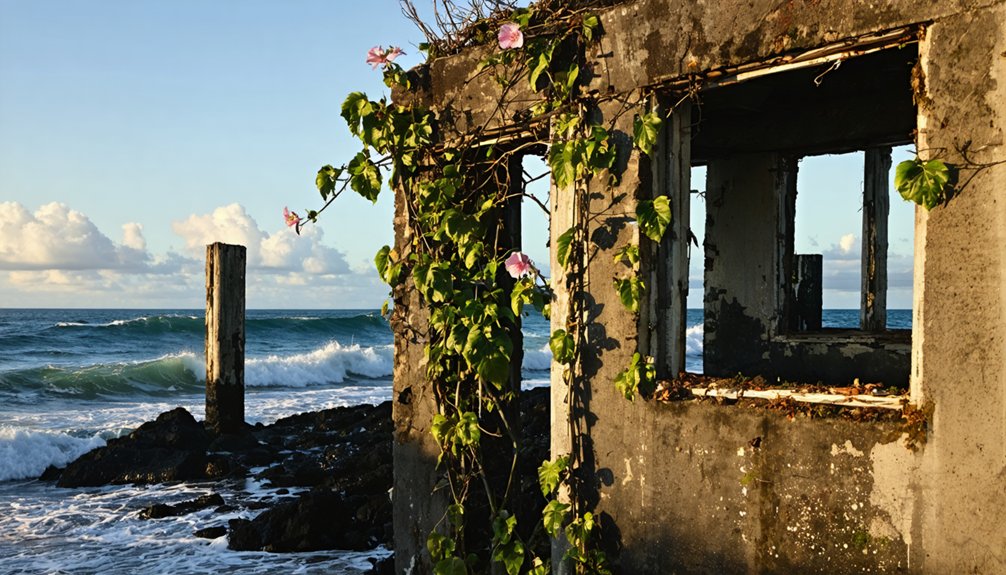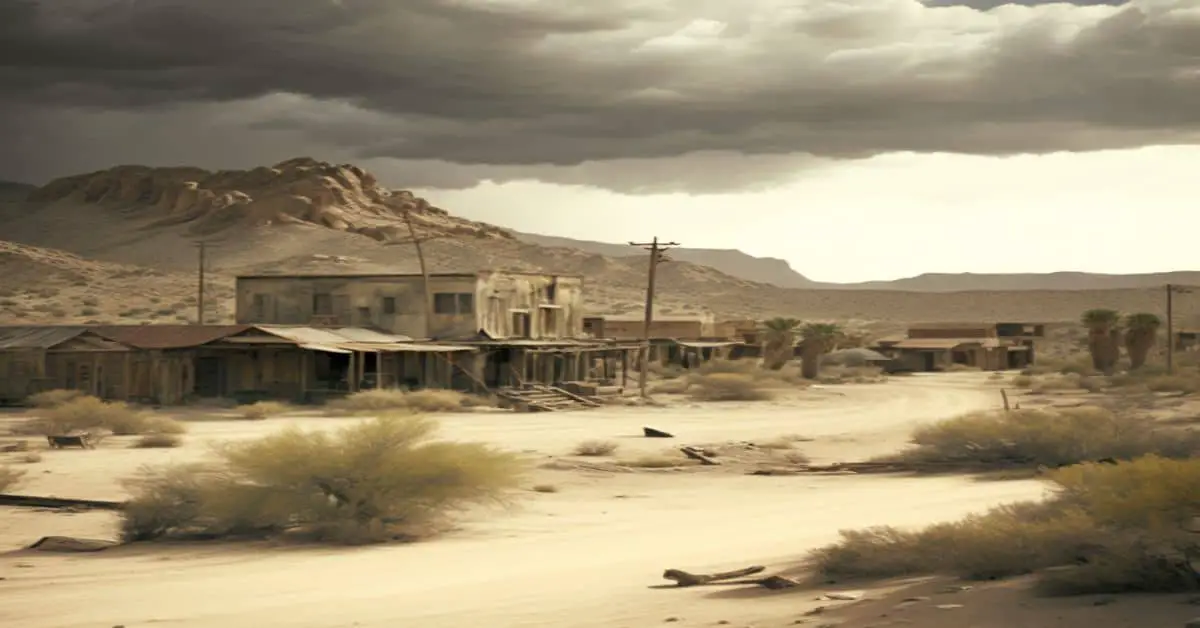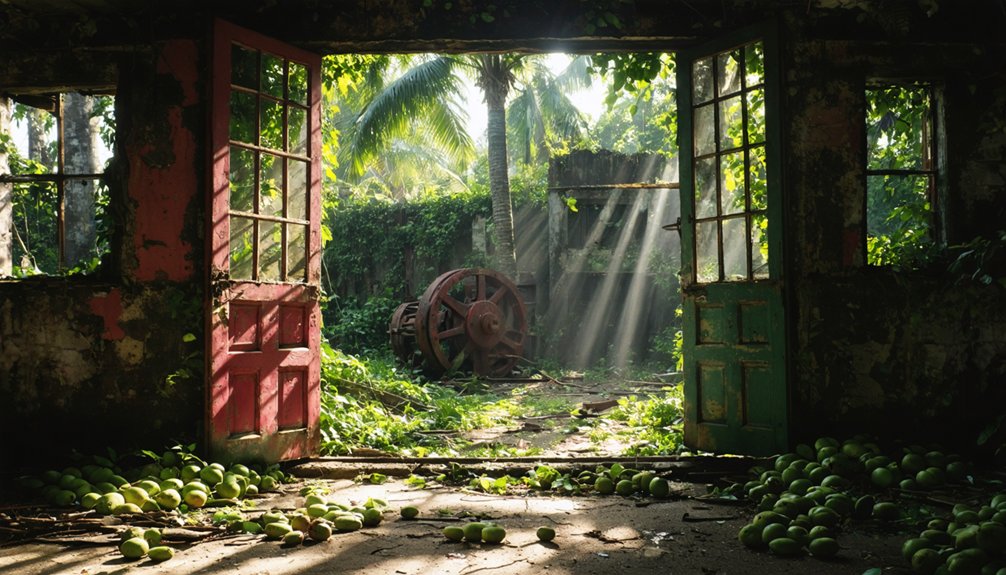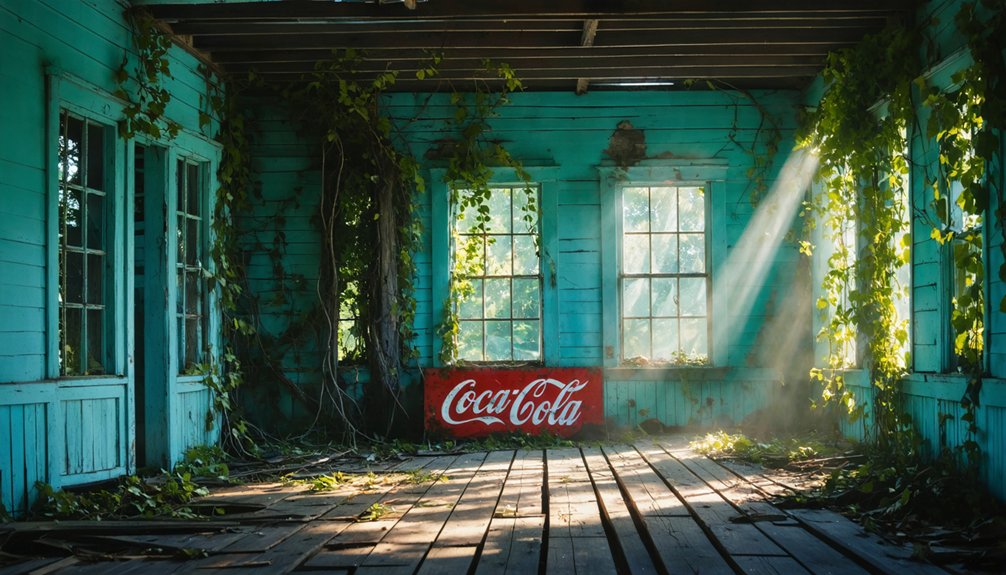You’ll find Laupahoehoe’s story etched in its quiet shores, where a once-bustling sugar port of 2,000 residents now rests in peaceful solitude. The devastating 1946 tsunami and closure of sugar mills transformed this vibrant harbor town into a more subdued coastal village. Today, nearly 1,000 residents honor both the area’s rich cultural heritage and sacred sites, while ancient lava flows and historical landmarks whisper tales of its dramatic past.
Key Takeaways
- Population declined dramatically from 2,000 residents during sugar industry peak to approximately 995 people today.
- The closure of sugar mills in the late 20th century led to significant economic decline and outmigration.
- Recent population losses include 33 residents (2017-2018) and 145 residents (2021-2022), showing continuing decline.
- Only remnants remain of the once-bustling harbor that handled sugar shipments and maritime transport.
- Young families frequently leave the area seeking new opportunities, though 69% homeownership rate reflects remaining community investment.
The 1946 Tsunami That Changed Everything
While natural disasters have long shaped the Hawaiian Islands, none left a more indelible mark on Laupāhoehoe than the devastating tsunami of April 1, 1946.
As dawn broke that morning, you’d have found teachers and students arriving at their seaside school, unaware of the destruction racing toward them from Alaska’s distant shores. Teacher Marsue McGinnis miraculously survived by clinging to floating debris.
The tsunami’s impact proved catastrophic. Without warning systems in place, massive waves crashed onto the peninsula, destroying teacher cottages and claiming twenty-four precious lives from the school community. The devastating waves completely destroyed teacher cottages along the shore, leaving only remnants of the once-thriving residential area.
You can still feel the weight of that morning’s tragedy in the stories passed down through generations. Yet through their grief, the community’s resilience shone as they banded together, relocating their school to higher ground and establishing memorials that honor both the land and the lives lost.
From Bustling Port to Quiet Village
You’d hardly recognize Laupahoehoe’s harbor today compared to its heyday when the bustling port handled thousands of tons of sugar and welcomed ships from across the Hawaiian islands.
After the railway’s construction in the early 1900s, the port grew even busier as it served both maritime and rail transport, helping sustain a thriving population of 2,000 residents. Today, visitors can still explore Lapahoehoe Point and its scenic coastal views while learning about the area’s rich history.
A devastating 1946 tsunami forever changed the landscape of this historic harbor. The closure of the sugar mills in the late 20th century triggered a steady exodus of workers and families, transforming this once-vibrant port town into the quiet village you’ll find today.
Historic Port Activities
As the gentle Pacific waves lap against Laupahoehoe’s rocky shores today, it’s hard to imagine this quiet village was once a bustling port town anchored by the mighty sugar industry.
You’d have seen trains winding through over 3,100 feet of tunnels and across steel trestles, all built between 1909 and 1913 to serve the thriving sugar mills.
The Laupahoehoe Sugar Company, established in 1883, brought life and movement to these shores, with workers guiding teams of mules and oxen through the fields.
A small boat ramp remains as one of the few reminders of the harbor’s former maritime activities.
Ships dotted the harbor, carrying precious cargo between the islands until the devastating 1946 tsunami changed everything.
Today, visitors can explore the station master’s office, now transformed into a museum preserving the railroad’s rich history.
The waves that once carried prosperity now serve as a reminder of Laupahoehoe’s remarkable transformation from industrial hub to peaceful seaside village.
Population Migration Patterns
The transformation of Laupahoehoe from a bustling port to a quiet village tells a story through its population numbers.
You’ll notice the dramatic migration trends, with the community losing 33 residents between 2017-2018, followed by a steeper decline of 145 people from 2021-2022. These community shifts reflect our changing island lifestyle.
The U.S. Census Bureau data reveals clear demographic shifts affecting this historic area.
The area’s 69 percent homeownership rate suggests many residents remain deeply invested in the community despite population changes.
While some might see only statistics, we see ‘ohana moving away in search of new opportunities.
Nearly a quarter of residents have relocated within the past year, more than double our region’s average. Even as median household incomes and property values remain stable, young families often choose to leave.
Today’s population of 995 represents a delicate balance between those who maintain deep roots in Laupahoehoe and those seeking opportunities elsewhere.
Cultural Heritage and Sacred Sites
Sacred wisdom flows through Laupahoehoe’s cultural landscape, where Hawaiian traditions and introduced influences interweave to create a rich tapestry of heritage.
You’ll find this legacy preserved at the historic Jodo Mission, which served as the first head temple of its sect from 1903 to 1907, marking the beginning of a unique cultural fusion. The temple’s detailed wood carvings on its gables showcase the architectural artistry of the era.
The sacred traditions live on at Laupahoehoe Point, where cultural preservation efforts honor both the land’s spiritual significance and its tragic connection to the 1946 tsunami.
At Laupahoehoe Point, ancient spiritual traditions merge with solemn remembrance of those lost to nature’s devastating power in 1946.
As you explore the Laupahoehoe-Humu’ula forests, you’ll discover how local communities maintain their deep connection to these ancestral grounds.
The Magical Creatures Sanctuary exemplifies the area’s continued commitment to caring for the land, while community-led initiatives guarantee these sacred spaces and practices endure for future generations.
The solemn granite memorial stone stands as a powerful reminder of the 24 lives lost to nature’s fury, connecting present-day visitors to the area’s poignant history.
The Story of Laupahoehoe School
Deep within Laupahoehoe’s cultural landscape stands a tribute to both triumph and tragedy – our beloved school, first established in 1883 at Laupahoehoe Point.
For generations, you’d find our keiki learning near the ocean’s edge, until nature’s fury changed everything. On that fateful April morning in 1946, a devastating tsunami claimed twenty-four precious lives, including nineteen of our children.
Yet our school history speaks of incredible community resilience. In 1952, we rose again on higher ground, in a magnificent structure designed by Alfred Preis.
Using our island’s own materials – ohia wood posts and local lava stones – the new school blended modern design with Hawaiian spirit.
Today, you’ll find this sacred place still serving as our community’s heart, a symbol of Laupahoehoe’s enduring strength.
Natural Landmarks and Ancient Lava Flows
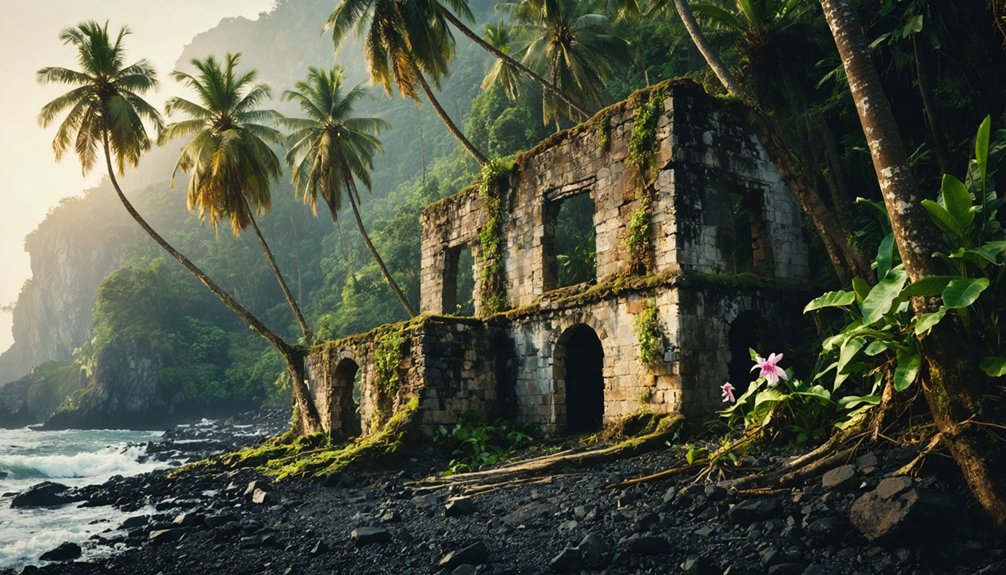
Along Laupahoehoe’s windswept shores, ancient pāhoehoe lava flows have sculpted our land into nature’s masterpiece, where smooth, billowy formations give our home its poetic name – “leaf of lava.”
You’ll find these sacred flows stretching from Mauna Kea’s slopes down to our dramatic coastline, creating a rugged peninsula that juts proudly into the Pacific.
Our coastal ecology thrives where lava formations meet the sea, creating rich habitats that our ancestors treasured.
At Laupahoehoe Point Beach Park, you’ll discover:
- Exposed volcanic rock formations that tell stories of ancient eruptions
- Native plant communities surviving in cracks and crevices
- Natural tide pools teeming with marine life
From sea level to 4,600 feet up Mauna Kea’s slopes, five distinct native ecosystems paint our landscape, each nourished by pure mountain streams.
Life in Modern-Day Laupahoehoe
Despite what you might assume from its “ghost town” reputation, Laupahoehoe pulses with life through its nearly 1,000 residents who’ve maintained strong cultural ties to their Hawaiian roots.
You’ll find a tight-knit community where homeownership exceeds 73%, families gather in households averaging 2.7 persons, and a diverse population blends Native Hawaiian, Asian, and European ancestries.
While residents face longer commute times and some economic challenges, they’re actively working on community development projects to preserve their town’s unique character while building a sustainable future.
Population and Daily Living
While many small Hawaiian towns have struggled to maintain their populations, Laupahoehoe has experienced remarkable growth, with residents increasing from 473 in 2000 to over 1,100 today. This population dynamics reflects strong community resilience, with a diverse mix of cultures calling this coastal haven home.
You’ll find a rich tapestry of local life shaped by:
- A multicultural community where Native Hawaiian, Asian, White, and multiracial families live together
- Long commutes averaging 44 minutes, with most residents maintaining two cars
- A strong connection to place, with 73.5% of residents choosing to own homes despite high property values
Daily life moves at a relaxed pace, though economic challenges persist with over a third of families facing poverty.
Still, the community’s growth suggests Laupahoehoe’s enduring appeal as a peaceful coastal sanctuary.
Local Culture Today
In modern-day Laupahoehoe, you’ll find a vibrant cultural tapestry where Hawaiian traditions seamlessly blend with contemporary life.
Cultural resilience shines through annual events like the Laupāhoehoe Music Festival, where community unity flourishes amid live performances, lei making, and local crafts.
You’ll experience the deep connection to ‘aina and kai through outdoor activities at the beach park, where families gather for sports, celebrations, and quiet reflection.
Traditional artisanship thrives as residents craft koa wood pieces and weave native materials, while local vendors share authentic Hawaiian cuisine at community events.
The spirit of ‘ohana remains strong as cultural knowledge passes between generations through school programs, hula performances, and regular gatherings that keep Hawaiian values alive in this close-knit coastal community.
Community Development Projects
Modern-day Laupahoehoe stands as a demonstration to thoughtful community development, where respect for Hawaiian values guides infrastructure growth.
You’ll find community revitalization efforts transforming this historic area through strategic infrastructure enhancements that honor both progress and tradition.
Key developments shaping Laupahoehoe’s future include:
- A $2.57 million renovation of the Transfer Station, ensuring sustainable waste management for generations.
- Harbor improvements with a 200-foot breakwater, supporting local fishermen and maritime activities.
- DHHL’s commitment to expanding housing options, including kūpuna residences and agricultural homesteads.
These projects reflect a deep understanding of ‘āina (land) stewardship while addressing practical needs.
From the innovative mushroom growhouse at Hamakua Heritage Farms to the expanded recreational facilities at Laupahoehoe Point Park, each development strengthens the community’s foundation for sustainable growth.
Preserving the Past: Historical Landmarks
Today’s Laupahoehoe stands as a living memorial to Hawaii’s rich cultural heritage, with numerous historical landmarks dotting its dramatic coastline and uplands.
You’ll discover the poignant Tsunami Memorial overlooking the bay, honoring 24 lives lost in the 1946 disaster. The historical preservation of ancient stone shelters and foundations in the Laupahoehoe-Humu’ula region tells the story of 1880s ranch life, while the Train Museum captures the sugar plantation era through carefully preserved artifacts.
Experience Laupahoehoe’s poignant history through its memorials, preserved ranch ruins, and a train museum showcasing Hawaii’s plantation past.
The landmark restoration efforts extend beyond physical structures to embrace oral histories, recorded by local kūpuna who share deep connections to the ‘āina.
Sacred places like Keanakolu, Lahohinu, and Keahua-ai continue to hold cultural significance, reminding visitors of the area’s roots as a peaceful Hawaiian fishing village.
Frequently Asked Questions
What Is the Average Home Price in Laupahoehoe Today?
With property values falling 27.9% last year, today’s housing market shows average home prices between $595,000 and $805,000 in this sacred land, where you’ll find diverse options from $299,000 to $1.4 million.
Are There Any Hotels or Bed-And-Breakfasts Operating in Laupahoehoe?
You’ll find Mahana House Country Inn and possibly Akiko’s Buddhist B&B as your main local accommodations. Don’t expect traditional hotels – most visitors stay in Hilo or explore vacation rentals nearby.
What Job Opportunities Are Currently Available in Laupahoehoe?
Like ocean waves bringing treasures to shore, you’ll find diverse opportunities flowing into the local economy. You can access healthcare, tourism, postal, sanctuary work and remote positions in today’s adaptable job market.
How Long Is the Commute From Laupahoehoe to Hilo?
You’ll spend about 34-37 minutes driving or 69-74 minutes by bus along scenic routes between these points. The Hamakua Coast’s beauty makes your commute worthwhile, whether you’re choosing car or bus.
Does Laupahoehoe Experience Frequent Power Outages During Storms?
You’ll find power outages during storms aren’t especially frequent, though it’s wise to maintain storm preparedness. When outages occur, power restoration is typically quick thanks to HECO’s responsive service systems.
References
- https://tsunami.org/qrcodes/laupahoehoe/
- https://dlnr.hawaii.gov/ecosystems/files/2013/07/Cultural-Historical-Report-Lapahoehoe.pdf
- https://www.environment-hawaii.org/?p=3196
- https://en.wikipedia.org/wiki/Laupāhoehoe
- https://www.ghosttowns.com/states/hi/laupahoehoe.html
- https://kids.kiddle.co/List_of_ghost_towns_in_Hawaii
- https://www.greencaviartravelblog.com/2019/09/hawaii-adventure-series-laupahoehoe-and.html
- https://www.hmdb.org/m.asp?m=94338
- https://tsunami.org/1946-laupahoehoe-hawaii/
- https://www.youtube.com/watch?v=u_aY-zfxFX0
